Africa Orientale Italiana:
Italian Pieces, Part One
by Mike Bennighof, Ph.D.
December 2018
 The Italian army that defends East Africa in Panzer Grenadier: Africa Orientale Italiana is a bayonet army, counting on its foot soldiers (and some very rugged terrain) to hold off the British invasion. The Italians have some impressive numbers on paper, but most of these troops are conscripted locals intended for internal-security duties rather than war against a modern, well-armed and well-trained foe. The Italian army that defends East Africa in Panzer Grenadier: Africa Orientale Italiana is a bayonet army, counting on its foot soldiers (and some very rugged terrain) to hold off the British invasion. The Italians have some impressive numbers on paper, but most of these troops are conscripted locals intended for internal-security duties rather than war against a modern, well-armed and well-trained foe.
Let’s have a look at how the game portrays them, starting with the infantry.
Infantry
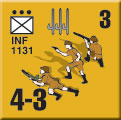  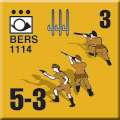
Italian infantry organization reflected the shortcomings of the Italian educational system, which could not provide enough suitable candidates to fill non-commissioned officer slots (or junior officers either). The Italian infantry platoon was about the same size as those of their opponents (36 men, compared to 32 or 37 for the British and Empire armies; the German platoon of this period had 46 men on paper). But where the British platoon had three squads, each with a Bren light machine gun, the Italian platoon had but two, though each had two Breda M30 light machine guns.
The problem came in how these weapons – more difficult to use than the Bren, and thereby less effective – were allocated. Each squad had two groups. The rifle group consisted of eight men, all armed with Mannlicher-Carcano M1891 rifles and led by an NCO. The machine gun group, also led by an NCO, was in turn divided into two fire teams, each with a Breda light machine gun served by a gunner and two ammunition carriers, plus an NCO to lead them. A commander and second-in-command, both lieutenants, rounded out the roster – the platoon had no headquarters element, not even a runner.
This unwieldy organization goes far to explain the ineffectiveness of Italian infantry during the war, particularly on the attack. The rifle group leader had no organic automatic weapon with which to establish a base of fire – he had to depend on the machine gun group to supply the firepower. In theory the squad leader had two fire teams with which to maneuver, but in practice the numbers and the intervening level of command caused the two groups to operate as separate squads. That also cut the platoon commander out of some tactical decisions, further deepening the Royal Army’s deadly chasm between officers and men.
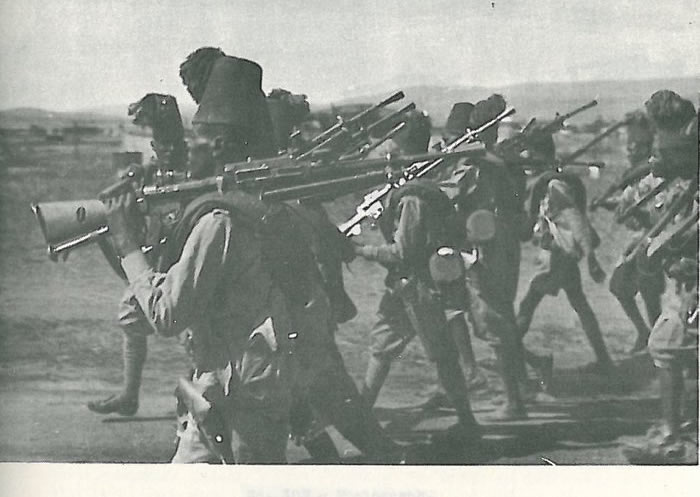
This Eritrean askari carries a Breda M30 light machine gun (as do his friends).
On paper, at least, colonial infantry followed the same tables of organization as the Royal Army’s metropolitan regiments. Africans could serve as non-commissioned officers, but not officers, and the colonial forces seem to have suffered an even greater deficit in small-unit leadership than the regular “white” army. By 1941 the Eritrean and Somali battalions also carried the M1891 rifle; many of the newly-established Ethiopian formations had Austrian-made M1895 Mannlicher straight-pull bolt action rifles taken from captured Austro-Hungarian or Ethiopian stocks.
One key reason for the Royal Army’s shortage of small-unit leaders lay in its establishment of elite infantry units. The intelligent, motivated young men who might have been sergeants in the line regiments served in the ranks of the Grenadiers, Bersaglieri, Alpini, paratroopers or Marines instead.
The Italian garrison of East Africa had just one battalion of Bersaglieri, the elite quick-stepping light infantry. They saw intense action during the battles of Keren. A Bersaglieri platoon was larger than its regular infantry equivalent, though also split into two squads. Each squad likewise had two groups, but instead of dividing the riflemen and machine-gunners, each such group had a rifle component and a machine gun component. In effect, the Bersaglieri platoon had four 10-man squads each with a four-man fire team, five riflemen and a leader, but labelled them differently than other armies.
Grenadier platoons followed the same unwieldly organization as regular infantry units, but saw better performance thanks to the very high quality of their soldiers, NCO’s and officers. In Africa Orientale Italiana we use Bersaglieri pieces to represent troops of the Savoy Grenadier Division, since their ratings would be the same, but it would be fun to replace them with true granatieri pieces someday.
Machine Gunners
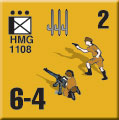 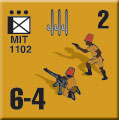 
Italian organization kept heavy machine guns at the battalion level, with one platoon of four weapons. The colonials had the Fiat Model 1914, a slow-firing and balky water-cooled weapon that fired the same 6.5mm round as the Mannlicher-Carcano rifle, but unlike the Breda M30 light machine gun it could not be loaded with rifle clips. It did have the odd ability to fire one round at a time.
The Breda Model 1935 air-cooled machine gun fired an 8mm round, using an unusual strip-feed that returned used brass to the tray from which the weapon was fed. It was prone to jamming, but still a much better weapon than the M1914.
Bersaglieri units (and the Savoy Grenadiers) had the new M1937, an air-cooled weapon that also used the curious self-brass-policing strip system. Each round had to be oiled, which led to frequent jamming in dusty environments, and the strip only held 20 rounds, which slowed its rate of fire. But the slower rate of fire limited overheating, allowing much longer sustained firing than other such weapons, and the large 8mm round offered greater range and penetration. But it was a heavy, bulky weapon and the Royal Army expected it to be carried by its crew rather than in a truck.
Italian heavy weapons companies also included a platoon of tiny Brixia 45mm breechloading mortars, usually parceled out to the rifle platoons and thus not shown at Panzer Grenadier scale. Colonial units don’t appear to have been issued with this weapon; there’s no difference in their firepower since the mortar didn’t add a whole lot of firepower. In many units, the troops seem to have preferred using the small “Red Devil” rounds as grenades and simply thrown them in mass as “grenade showers.”
Engineers

Italian infantry divisions had a fairly small engineering establishment; on paper they fielded a battalion with just two companies, one of combat engineers and one of construction engineers. A signals company usually fell under the engineer battalion headquarters for administrative purposes.
In Italian East Africa the Savoy Grenadier Division had its own engineer battalion. The colonial divisions did not have organic engineer assets, but all four of those in the Eritrean sector had an attached combat engineer company. Those in the other sectors rarely had one. Combat engineers in East Africa appear to have been exclusively white Italians, while the large array of construction units included many African personnel.
Combat engineers proved vital during the Italian retreat to Keren on the Eritrean front, using demolitions to create massive rock obstacles in the narrow passes through which the British and Indians had to advance. The Italian commanders, Luigi Frusci on the Eritrean front and his boss Amadeo the Duca d’Aosta, understood this and rarely allowed them to be committed to the front lines as infantry.
And those are the Royal Italian Army’s foot soldiers, as seen in Africa Orientale Italiana. Next we’ll look at their support weapons and vehicles.
You can order Africa Orientale Italiana right here.
Sign up for our newsletter right here. Your info will never be sold or transferred; we'll just use it to update you on new games and new offers.
Mike Bennighof is president of Avalanche Press and holds a doctorate in history from Emory University. A Fulbright Scholar and award-winning journalist, he has published over 100 books, games and articles on historical subjects.
He lives in Birmingham, Alabama with his wife, three children and his dog, Leopold.
|
